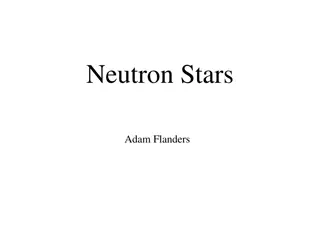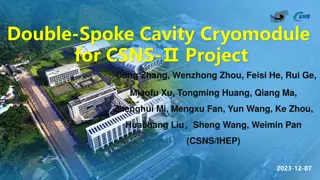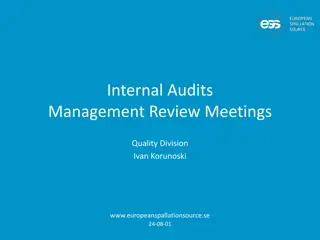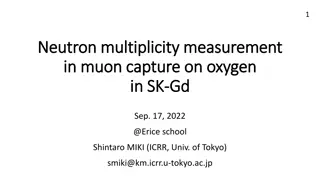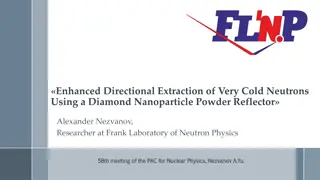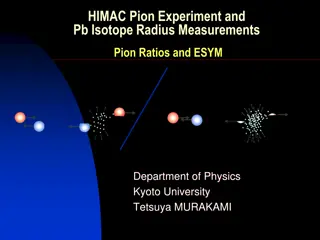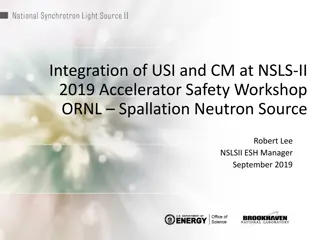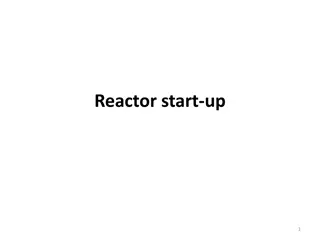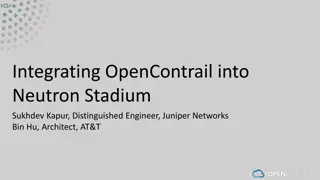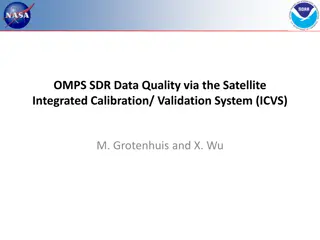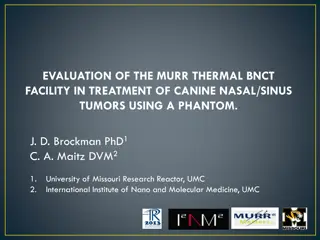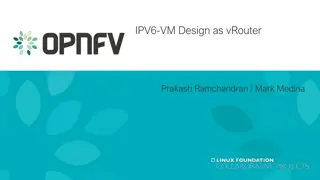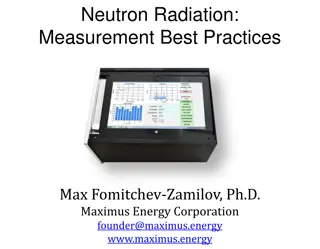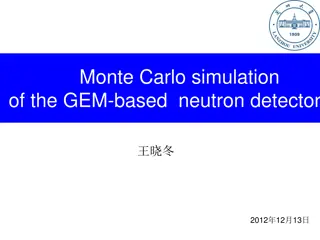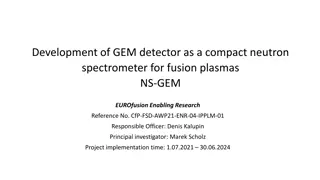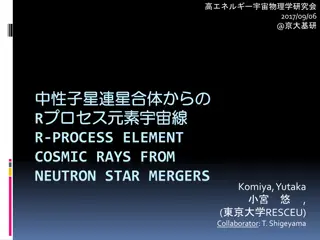European Spallation Source Neutron Instrument Project Overview
The European Spallation Source (ESS) Neutron Instrument Project aims to develop 15 world-leading neutron instruments by 2023. The project involves instrument classes, performance targets, budget considerations, and a planned schedule for instrument commencement. The NSS project scope includes reducing to 15 instruments, with plans for eight to be operational by August 2023. Lead consortia are identified for instrument development, and the project prioritizes early scientific output delivery. The instruments cover a range of applications from small angle scattering to spectroscopy.
Download Presentation

Please find below an Image/Link to download the presentation.
The content on the website is provided AS IS for your information and personal use only. It may not be sold, licensed, or shared on other websites without obtaining consent from the author. Download presentation by click this link. If you encounter any issues during the download, it is possible that the publisher has removed the file from their server.
E N D
Presentation Transcript
ODIN Tollgate 2 NSS status and meeting objectives Shane Kennedy NSS Project Leader European Spallation Source ERIC www.europeanspallationsource.se 24thFebruary 2017
The 15 NSS Project Instruments All are funded to be world leading in 2023 Instrument Class Costbook Value (M ) Instrument Performance targets (@ 2MW) 12.19 5 x D22 & 20 x SANS2D LOKI (Broad band SANS) 11.50 4 x D22 SKADI (General Purpose SANS) (+SONDE funds) Large Scale Structures Conventional mode: ~ 100 x D17 High intensity mode: 1cm2samples = seconds 11.80 ESTIA (Focusing Reflectometer) 13.2 30 x FIGARO, INTER FREIA (Liquids Reflectometer) 13.66 > 10 x POWGEN or WISH DREAM (Bispectral powder diffractometer) With a further ~ 53 M investment ESS will more than 13.55 ~ 50 x GEM, ~ 8 x new POLARIS HEIMDAL (Hybrid diffractometer) Diffraction Cold: > 100 x worlds best, Thermal: 1mm3crystals = 10 min 13.10 MAGIC (magnetism single crystal diffractometer) double the performance of these instruments 11.67 > 10 x LADI & Biodiff NMX (Macromolecular crystallography) 14.99 world leading in strain scanning, unique flexibility BEER (Engineering diffractometer) Engineering & Industrial 11.60 world leading for high resolution, > 10 x best for TOF methods ODIN (multi-purpose imaging) 13.45 > 10 x THALES & MACS BIFROST (extreme environment spectrometer) 16.50 100 x IN5 (w RRM) C-SPEC (cold chopper spectrometer) Spectroscopy 16.85 3 x 4-SEASONS, 3 x IN5 T-REX (bispectral chopper spectrometer) 12.0 10 x VISION ( E = 130 meV) VESPA (vibrational spectroscopy) 13.53 2 x BASIS and DNA MIRACLES (backscattering spectrometer) 199.59 Total cost book value 2
NSS project scope, budget and priorities Outcome of ESS ERIC Council meeting (5th- 6thDecember 2016): Reduction of NSS project scope to 15 instruments approved* Authorization for Science Director to approve Neutron Instruments passage through Tollgate 2 Noted by council: Plan for eight instruments for start of user operations in August 2023 All 15 instruments will view the upper moderator (giving freedom to optimize a lower moderator for new applications in the future) * Includes provision for NSS to draw up to 15.1 M from ESS contingency if necessary to complete the project 3
Planned order of commencement of operation of first 8 instruments (August 2023) Matching early success in delivery of scientific outputs with the capacity of Lead In-Kind partners to deliver on schedule (ISIS, PSI, FZJ, LLB, HZG/NPI, TUM/PSI, TUM/LLB & DTU lead consortium). Instrument Class Sub-class Candidates Instruments in bold type to be operational by Aug 2023 Small Angle Scattering LOKI (ISIS) or SKADI (FZJ) Large Scale Structures Reflectometry ESTIA (PSI) or FREIA (ISIS) Powder Diffraction DREAM (FZJ) or HEIMDAL ( U) Diffraction Single crystal diffraction MAGIC (LLB) or NMX (ESS) Italic: Strain scanning BEER (HZG/NPI) backups in case of delays Engineering Imaging and tomography ODIN (TUM/PSI) Direct Geometry C-SPEC (TUM) or T-REX (FZJ) Spectroscopy Indirect Geometry BIFROST (DTU), MIRACLES (Bilbao), VESPA (CNR) 4
NSS Neutron Instrument positions: December 2016 Nuclear Physics Institute Two instruments have moved once; ESTIA; E1 -> E2 for cleaner view of source DREAM ; S4 -> S3 for more space + ESS Lead Partners for instrument construction NMX BEER C-SPEC BIFROST MIRACLES MAGIC SKADI has moved twice; DREAM T-REX ODIN 1. from E8 -> E5 for more space HEIMDAL 2. from E5 -> E3 to allow more space for ANNI VOR LoKI FREIA VESPA SKADI ESTIA 150 m 50 m 100 m ESS In-Kind Partners also collaborate on sample environment, data management systems etc. ESS Instrument Layout (June 2016) 5
Neutron Instruments: Phase 1 schedule 2016-17 May Jun Jul Aug Sep Oct Nov Dec Jan Feb Mar Apr LOKI (P2) 10/5 SKADI 20 10 29 ESTIA 29 20 15/6 14- FREIA 17 NMX (P2) MAGIC 31 19 22-23/6 HEIMDAL 31 DREAM 8 14 BEER 7 14 17/6 ODIN 5 24 C-SPEC 3 7 BIFROST 12 24 STAP 12-13/9 21 MIRACLES scope-setting T-REX 28 8 TG2 27 VESPA IKON11 COUNCIL ICB SAC IKON12 ICB
Neutron Beam Instrument Construction Working Schedule: V3.0, 9thDecember 2016 Access to NSS areas Ready for Beam on Target Hot Start User Program Current date Early bldg access dates; Monolith (D02) North (D03) 1 Nov 19 East (D01-E) South (D01-S) West (4 areas) Guides (D03-W) 1 Nov 19 Guides (E02-2) 15 Oct 19 Guides (E02-1) 27 Apr 19 Caves (E01) Commission instruments 7 Feb 19 6 Jan 20 2 Mar 20 West sector Provisionally aligned with Accelerator planning ESS internal working schedule: North sector still under discussion with the ERIC Council East and South sectors Preliminary Design Detailed Design Manufacturing & Procurement 2016 2017 2018 2019 2020 2021 2022 2023 2024 2025 Installation & Integration Hot Commissioning/Early science Installation for most instruments begins in Q2/2019 with in-monolith optics Access to other instrument construction areas will be later (see top left panel) Operation 7
2019/2020: NSS Proposed Access Dates (Excludes Full Access Dates) D08 RML Lab Early Access 10-Jan-19 (Level 1b MS) 1 2a E05 E01 Full Access 27-Apr-19 (Level 1 MS) 2b E04 E02 Area 1 Partial Access 27-Apr-19 (Level 1 MS) 3 D03 Bunker * Early Access 03-Jun-19 (Level 1 MS) E01 4 D01 Bunker * Early Access 14-Aug-19 (Level 1 MS) 2a E03 5 E02 Area 2 Partial Access 15-Oct-19 (Level 1b MS) 2b D03 Main Hall Partial Access 01-Nov-19 (Level 1b MS) 6 E02 7 D01 Main Hall Ph 1 Partial Access 06-Jan-20 (Level 1b MS) 5 Exact Location of Final De-Lineation Point TBC D01 Main Hall Ph 2 Partial Access 02-Mar-20 (Level 1b MS) 8 D05 D04 Additional Area Made Available for Storage of Blocks (D03) for NSS: 01-Sep-19 Operational: 13- Aug-19 6 3 D03 Cranes 4 D06 D08 8 Additional Area Made Available for Storage of Blocks (D01) for NSS: 01- Oct-19 Operational: 28- Oct-19 1 7 D01 Cranes Area Under Review for Possibilities of Early Access for NSS D07
NSS Floor loading limits 30 t/m2 1. Under the bunker (D02 & inner parts of D01 & D03); 2. In the rest of D01 & D03 14 t/m2 a) In general (under guides & instrument caves); Reduced in February 2017 10 t/m2 b) Around perimeter (3 metres from wall); 20 t/m2 c) Staging areas (near truck access doors); 20 t/m2 3. In E01 & E02 (long instruments in west sector); 9
NSS Project; Neutron Instrument project phases Design and Construction Installation and Commissioning Proposal and Planning Phase 0 Preparation for Design Phase 1 Phase 2 Phase 3 Phase 4 Phase 5 Instrument Proposal Preliminary Design Detailed Design Manufacturing and Procurement Installation and Integration Hot Commissioning Deliverables Deliverables Deliverables Deliverables Deliverables Deliverables Deliverables Scientific and technical requirements Science case covering scientific relevance, impact and usage Conceptual design updates Complete definition of all major technical components Procurement and manufacture of all major technical components Construction of physical infrastructure on site. Verification of performance of Personnel Safety System Assembly and installation of technical components Technical design concept Prototyping Completion of detailed plan for Phase 3 Completion of detailed plan for phase 4 Proof of compliance with radiation dose limits Definition of facility requirements and interfaces Delivery plan for all phases (including hot commissioning) Refined plan for phase 4 Integration and testing of technical components Conceptual design with credible estimates of performance Site preparation Critical performance demonstration of basic functionality Refined Resource plan Refined plans for phase 5 and for staging Delivery Schedule covering all phases Clarification of institutional responsibilitie s Installation, integration and testing of Personnel Safety System Refined delivery schedule, with critical path items and dependencies Refined Resource plan Scientific performance demonstration Preliminary costing. Resource plan Refine instrument delivery schedule Submission of application for approval to hot commission Staging plan for later enhancements Resource planning Friendly user experiments Refined budget with contingency at 10% of cost to complete Maintain budget with contingency at 10% of cost to complete Budget with contingency at 10% of cost to complete Formal project completion Completion of technical and user manuals Tollgate 2 (PDR) Tollgate 1 STAP review SACrecommendation NSS recommendation STC approval Tollgate 3 (CDR) Tollgate 4 (IRR) Tollgate 5 (SAR) Tollgate 6 (ORR) Preliminary Design Review STAP review NSS scope review assign cost book value Approval by SD Critical Design Review STAP review ICB review NSS approval Installation Readiness Review ICB review NSS approval Safety systems acceptance review NSS approval Operations readiness review NSS approval 10
Tollgate 2 Process TOLLGATE 2 MEETING: evaluation of final technical design concept, scientific scope, project budget, schedule and resource plan TOLLGATE 2 REVIEW possible outcomes: No major problems: implement recommended changes and revise baseline documents, before moving instrument project into Phase 2 (< 3 months allowed). Major problems: continue in Phase 1 and prepare for a second TG2 review (< 6 months allowed). Review committee report submitted to Science Director within two weeks of TG2 meeting 11
Objectives for this meeting scientific parameters -that it will meet the stated performance criteria (TPM), engineering -that it is feasible to build with all of the appropriate interfaces, safety and licensing -that it meets the requirements for safe operations and licensing budget -that it can be built within the budget, schedule -that it can be built and made ready for hot commissioning in the required timeframe management -that the instrument consortium has the capability and sufficient resources to deliver according to their plan. Operation and maintenance that it can be operated (incl. performing experiments using samples and sample environment) and maintained. (ESS-0051706) 12
Phase 2: detailed design (1/2) Aim: To bring the design of the Neutron Instrument components to a state of readiness for Manufacturing and Procurement (M&P). Essential achievements: Complete detailed design of all major components coherently so as to minimize risk of incompatibilities and need for redesign work as the Project moves into Phase 3: M&P. Detailed planning for M&P. Note Phase 2 does not include M&P. Exception: where long lead-time procurements add considerable risk to project schedule. Approval to begin early M&P: by NSS Project via Neutron Instruments Lead Engineer (Gabor Laszlo). Detailed planning for Phase 4: Installation and Integration. Technical Annexe for whole of project to be completed within 3 months of Phase 2 Draft Template for the TA is available (to be finalized within 2 weeks) 13
Phase 2: detailed design (2/2) Notes on Phase 2: Careful scheduling of Phases 3 & 4 ensures resource planning for M&P processes (e.g. FAT & SAT), site preparation, installation and system integration, cold commissioning activities and licensing processes. Critical dependencies should be identified and a critical path analysis should be performed in this phase. Support from the NSS Project Office will include construction managers under leadership of the NSS Construction Engineer. The NSS Construction Engineer will develop and maintain an integrated installation plan that takes into account the procurement schedules for all Neutron Instruments, CF building schedules, and resource allocation. 14
NSS Project management Director for Science Andreas Schreyer ESS Technical Board Chair: Roland Garoby Instrument Collaboration Board Chair: Andreas Schreyer Project Leader: Shane Kennedy Deputy Project Leader: Oliver Kirstein Neutron Instruments: Lead Scientist: Ken Andersen Lead Engineer: Gabor Laszlo In-Kind Office: Integration Activities: Lead: Zvonko Lazic Safety and Licensing: Lead: Arno Hiess Planning: Lead: Michela Del Anno Boulton Lead: Sofie Ossowski Budgets & workflow Neutron Bunker Partner coordination SSM application ODIN (TUM/PSI) LOKI (ISIS) Schedule Requirements & Standards Safety Systems analysis & design SKADI (FRJ) Memoranda of Understanding BEER (HZG/NPI) Risk Management ESTIA (PSI) Systems Engineering Technical Annexes C-SPEC (TUM) Four Instrument Classes FREIA (ISIS) Large scale structures Conventional Facilities In-Kind Collaboration Agreements T-REX (FZJ) Engineering & imaging DREAM (FRJ) Spectroscopy BIFROST (DTU) Target Project Diffraction HEIMDAL ( U) MIRACLES (ESS Bilbao) NMX (ESS) Instrument Class Co- ordinator (scientist) assigned to each instrument VESPA(CNR) MAGIC (LLB) 15
NSS Project Integration Support NSS? PROJECT? INTEGRATION? TEAM Integrated Systems Neutron Bunker Beam inserts Choppers Transport optics Vacuum systems Shutters Shielding Cranes Penetrations Services Controls & sensors Remote handling Safety systems Project? ? ? ? ? ? ? ? ? ? ? Co-ordination? ? ? ? ? ? ? ? ? ? ? Sofie? Ossowski Instrument? Engineering? ? ? ? ? ? ? ? ? ? ? Gabor? Laszlo Integrated Processes In-kind agreements Technical annexes Project Management Tollgates Schedule risk Installation planning Integrated? Control? Systems? ? ? ? ? ? ? ? ? ? ? ? ? David? Brodrick In-Kind?Co-ordination? Michela? Dell'Anno? Boulton Instrument? Technologies? ? ? ? Iain? Sutton Engineering? Design? ? ? ? ? ? ? ? ? ? ? ? Zvonko?Lazic Iain Sutton TBA Installation? ? ? ? ? ? ? ? ? ? ? co-ordination? ? ? Antonio?Bianchi Systems? Engineering? Peter? S ngberg Personnel? Safety? Systems? ? ? Stuart? Birch Antonio Bianchi Safety? &? Licensing? ? ? ? ? ? ? ? ? ? ? ? to? be? recruited Gabor Laszlo 16
Central Utilities Building (CUB) Site Offices LINAC East sector Instruments South sector Instruments Target West sector (160 m) Instruments February 2017
Agenda for ODIN TG2 meeting Friday 24thFebruary 2017 18



